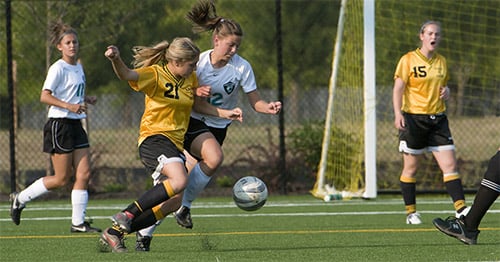Soccer Injuries and Conditions

Soccer is a popular sport that can lead to many types of injuries, from minor sprained ankles that keep players off the field for a couple weeks, to ankle fractures or ACL tears that sideline them for many months.
The increasing popularity of highly competitive and physically intense levels of play, especially among children and teenagers, has led to higher incidences of injury. Learn about injury prevention, conditions associated with this sport and various treatments for players in the articles below.
Soccer injury prevention – Get in shape
Soccer is a sport that requires both a level of aerobic (endurance) and anaerobic (strength) fitness. It is clearly best to have a good level of conditioning in both these areas, as the sport is very demanding. It is a sport that sets up a risk of injury if performed once or twice a week without being involved in other fitness activities. These would include aerobic conditioning such as running, biking, and elliptical training.
Additionally, it is also best to include a strengthening regimen that includes resistance training with weights, Pilates, and yoga. Core strengthening – a focus on the trunk of the body – is often overlooked but very important.
Although stretching has not been clearly shown to prevent injuries, it is felt to be of general benefit in terms of improving range of motion, flexibility, soreness, and healing.
Common soccer injuries
Specific injuries commonly seen in soccer involve the legs, from the hip to the toe. Injuries to the head and face are the second-most frequent injuries, with back-related problems coming in third.
These can be sudden, traumatic injuries that can be preventable or non-preventable. While events involving collision are usually not preventable, understanding the rules of the game are critical. The two rules that are the most important to observe focus on not contacting other players from behind and keeping the elbows below shoulder level when coming in contact with opponents.
It is rare to sustain a head injury such as a concussion from heading the ball. Most occur as a result of contact with another player or the head hitting the ground or the goalpost.
Lower extremity injuries (occurring below the waist) can also be caused by contact, but most – including knee ligament tears – are non-contact events. Anterior cruciate ligament (ACL) tears are most frequently the result of "cutting" from side to side, or landing from a jump. They occur more commonly in females. Prevention exercises and programs are essential in protecting yourself from an ACL injury. The HSS Sports Safety ACL Program provides specialized education for coaches, parents and athletes in hands-on workshops to prevent common knee injuries.
Other sudden injuries include ankle sprains or muscle tears and "pulls." Proper ankle taping and wearing ankle braces can aid in stability and should not have a negative impact on your game.
A strained muscle can commonly occur in the calf, hamstring, quadriceps, or groin. General conditioning as mentioned is the best prevention in terms of strains, and a proper warm-up routine is also important. The best warm-up aims to involve sport-specific activities involving kicking and light jogging, progressing to sprinting.
Overuse injuries can occur, and are the result of repetitive "micro-injury" such as tendonitis or stress fractures. These happen most commonly in the setting of, again, poor conditioning. They can also be seen at the other end of the spectrum, in which individuals are pushing activity beyond their level of conditioning. It is best to have at least one to two days a week of non-impact activities if an athlete is exercising daily.
In the news
- Why Are So Many Women Athletes Tearing Their ACLs Now?
- Doctor Breaks Down Carvajal, Alaba, and Militao’s Injury Issues at Real Madrid [Exclusive]
- “Militao will face a unique set of challenges after his second ACL tear,” says medical expert
- Inside Tyrone Mings’ 445-day road to recovery: Severe ACL injury, global rehab and muscle atrophy
- FC Monmouth Announces HSS As Club's New Front Of Shirt Sponsor
- Why ACL injuries are on the rise
- ACL injuries plague women's soccer
- Team ACL: The growing women’s soccer club that no player wants to join
- How Dangerous Are Soccer Concussions? They May Cause Lasting Damage
- Giants, Red Bulls team up for football vs. soccer drills
- Best Team Sports for Shedding Extra Fat
- US Youth Soccer partners with Hospital for Special Surgery (HSS)
- New York Red Bulls Expand Medical Staff with Additional Team Physicians from Hospital for Special Surgery
- Foley, Carbone win battle with ACL injuries
- Health experts offer tips on how to prevent youth ACL injuries
